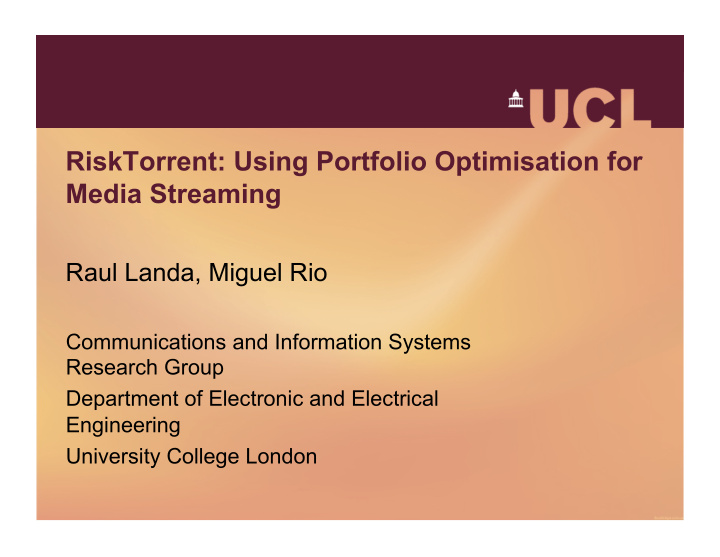



RiskTorrent: Using Portfolio Optimisation for Media Streaming Raul Landa, Miguel Rio Communications and Information Systems Research Group Department of Electronic and Electrical Engineering University College London
Definitions • Reciprocity : Peers need to upload in order to obtain j download capacity • Let’s call the throughput that peer uploads to peer i • The throughput that obtains from as a result is defined as
Modeling Reciprocity • The simplest model for is, simply where can be thought of the return that peer receives from , given an investment of
Modeling Total Download Throughput • The total return (throughput) for peer is then: • Thus, in this model, the total return that a peer obtains is a linear combination of the throughput that it allocates to all other nodes
Modeling Download Throughput Variability • We treat the asset returns as random variables – returns have nonzero volatility • The variance of , a linear combination of random variables, is then given by where is the covariance matrix of asset returns, and is the vector of assigned uploads
Media Streaming: The Investment View • Each possible allocation of upload bandwidth to specific peers then becomes a portfolio • For media streaming, we are interested in minimising throughput variability while maintaining a given stream rate • In this case, swarming protocol design becomes portfolio selection [Markowitz, 1952] and [Markowitz, 1959]
Media Streaming: The Investment View • The objective is to minimise portfolio risk while achieving a given return and satisfying a budget constraint . Diversification helps reduce risk while maintaining returns – the volatility of the portfolio is smaller than that of its components. Formally:
Media Streaming: The Investment View • The objective is to minimise throughput variability while achieving a given stream rate and satisfying a maximum upload capacity constraint . Formally: Throughput Variability Constant Stream Rate Maximum Upload Capacity
Media Streaming: The Investment View Throughput Variability Constant Stream Rate Maximum Upload Capacity Non-negativity Constraints (no short-selling)
Media Streaming: The Investment View Throughput Variability Constant Stream Rate Maximum Upload Capacity Non-negativity Constraints (no short-selling) What happens if the problem is unfeasible?
Media Streaming: The Investment View • Usually, this means that the peer has insufficient upload capacity ( capital ) to sustain the required stream rate ( return ) • In this case, peers fall back to maximising throughput , irrespective of risk:
Media Streaming: The Investment View • Usually, this means that the peer has insufficient upload capacity ( capital ) to sustain the required stream rate ( return ) • In this case, peers fall back to maximising throughput , irrespective of risk: Stream Rate Maximum Upload Capacity Non-negativity Constraints (no short-selling)
Simulations: Setup (Expected Returns) A B 1 C D
Simulations: Setup (Covariance Matrix) A D B C
Simulations: Achievable Stream Rate
Simulations: Risk (Standard Deviation)
Simulations: Protocol Operation Curves
Conclusions • A possible model for reciprocity-based peer-to- peer networks can be formulated based on portfolio optimisation • The model can be extended: – Multi-stage formulations – Asymmetric risk measures – More general reciprocity models • See [Steinbach, 2001] and references therein • Practical issues: – How can we measure the covariance matrix?
Thank You! • Any Questions?
References • Markowitz, H. M. (1952) “Portfolio Selection”. The Journal of Finance 7 (1): 77–91 • Markowitz, H.M. (1959) “Portfolio Selection: Efficient Diversification of Investments”. John Wiley & Sons. • Steinbach, M. C. (2001) “Markowitz Revisited: Mean-Variance Models in Financial Portfolio Analysis”. SIAM Rev. 43 (1): 31-85
Recommend
More recommend